Modelling and predicting the dynamic response of an axially graded viscoelastic core sandwich beam
2023-12-27SuryaraoNagiredlaSharnappaJoladarashiHemanthaKumar
Suryarao Nagiredla,Sharnappa Joladarashi,Hemantha Kumar
Department of Mechanical Engineering, National Institute of Technology Karnataka, Surathkal, Mangaluru, Karnataka 575025, India
Keywords:Finite element method Sandwich beam Viscoelastic material Natural frequency Loss factor Boundary condition Axial gradation
ABSTRACT The present study explored the influence of axial gradation of viscoelastic materials on the dynamic response of the sandwich beam for structural applications.The finite element(FE)formulations are used to model and investigate dynamic response of the sandwich beam.The classical beam theory is used to develop the FE formulations and Lagrange's approach is considered to obtain the equations of motion(EOM).FE code is developed and validated with the existing literature and also conducted the convergence study for the developed FE method.Further,the influence of different viscoelastic materials and boundary conditions on the dynamic response of the sandwich beam is investigated.Four different axial gradation configurations of viscoelastic materials are considered for the present work to explore the influence on natural frequency,loss factor and frequency response of the sandwich beam.The modeled axial gradation of viscoelastic material has displayed a considerable impact on the peak vibrational amplitude response of the sandwich beam for all the boundary conditions and these configurations improved the damping capabilities at different configurations for the structural applications.
1.Introduction

In structural applications,large amplitudes of vibration can cause significant problems and reduce the lifespan of mechanical structures.To mitigate this problem,avoiding or controlling the high amplitudes is necessary [1].One effective approach is to use viscoelastic damping materials,which can reduce or control structural vibrations to some extent [2-4].Due to their high stiffness-to-weight and strength-to-weight ratios,viscoelastic sandwich structures have become increasingly popular in various industries,including aeronautics,automotive,aerospace,defense,and civil engineering [5].Viscoelastic materials are materials that exhibit both viscous (fluid-like) and elastic (solid-like) behavior when subjected to stress or deformation.This means that they can deform and return to their original shape like an elastic material,but also exhibit some degree of viscosity,or resistance to flow,like a liquid and they can dissipate the vibrational energy in the form of heat when the structure undergoes deformation cycles [6-8].Oberst conducted a dynamic study on base beam structures for the first time with the viscoelastic material bonded to the base beam on one side [9].Even though the technique of applying damping material on one side of the base structure is provided a little damping to the structure,this technique fails to utilize the full damping capabilities of the viscoelastic material.This leads to constrained layer damping (CLD),in which viscoelastic material is placed between the two stiff elastic face layers.In CLD,the viscoelastic material tends to dissipate more energy due to higher shear deformations when the structure is vibrating [10-15].Rao et al.[16] discussed the behavior of sandwich beams under different boundary conditions.Authors determined natural frequencies and loss factors of sandwich beams under different boundary conditions.The theoretical model is developed to find the dynamic response of the sandwich beams.The model considers the effects of the geometry,material properties,and boundary conditions on the dynamic behavior of the sandwich beams.Zhou et al.[17]provided a comprehensive overview of the research and applications of viscoelastic vibration damping materials.The review covers the fundamental principles of vibration damping,including the mechanisms of energy dissipation and the basic properties of viscoelastic materials.Furthermore,the various applications of viscoelastic materials in engineering and technology,including the aerospace industry,automotive industry,and construction industry are discussed.The authors also discussed the use of viscoelastic materials in vibration isolation,noise reduction,and structural damping.Huang et al.[18] explored the damping properties of sandwich structures consisting of a layer of viscoelastic material sandwiched between two layers of elastic material.The study focused on the effects of the thickness and properties of the viscoelastic layer on the damping capacity of the sandwich structure.Hao et al.[19]discussed the damping behavior of a sandwich beam using an analytical approach.Baber et al.[20] presented the FE method for analyzing the dynamic behavior of viscoelastic sandwich beams under harmonic excitation.The proposed model focuses on accurately predicting the vibration and damping response under harmonic loading.The study found that the damping behavior of sandwich beams is influenced by the frequency and amplitude of the harmonic excitation.Bilasse et al.[21]presented a study on the dynamic response of viscoelastic sandwich beam using both linear and nonlinear analysis techniques.The study investigated the effects of material damping,core thickness,and boundary conditions on the vibration response of the beam.The linear analysis is based on the classical sandwich beam theory,while the nonlinear analysis employs a higher-order shear deformation theory.The study shows that the material damping and thickness have a significant effect on the vibration behavior.FE related methods are reported to study the viscoelastic-based sandwich beam's dynamic behavior [22-30].Lifshitz et al.[31]developed a theoretical model to optimize the design of sandwich beams for maximum viscoelastic damping.The results showed that the optimal design of sandwich beams for maximum viscoelastic damping involves selecting a viscoelastic layer with high loss factor and optimizing the thickness of the viscoelastic layer.Kung and Singh[32]discussed the use of CLD patches to reduce the vibrations of beams.The study focused on beams with multiple CLD patches that are constrained to move in the axial direction only.The author derived the EOM for a beam with multiple CLD patches using the Euler-Bernoulli beam theory.The results show that increasing the number of CLD patches and locating them at the antinodes of the vibration mode leads to better vibration reduction.Ilangovan et al.[33]explored the influence of nanoparticles inclusion on the modal parameters of composite tubes made of epoxy and basalt/epoxy or E-glass/epoxy.The analytical and numerical models developed in this study were well agreed with the experimental findings.Grewal et al.[34]performed the parametric study to address the influence of viscoelastic material on damping and developed an optimization problem to find the suitable number of viscoelastic patches to obtain the maximum damping for the structure.Gupta et al.[35,36]studied the effectiveness of graphite particulates inclusion in the core material on loss factor and performed a parametric study to find the optimal parameters for maximum damping in the sandwich structure.However,to achieve optimal or higher damping for the sandwich beam or plate applications,some studies reported the effectiveness of partial and full treatment of viscoelastic patches on loss factors[37-40].
From the available literature it is learnt that numerous studies are available on the dynamic response of the sandwich beam with viscoelastic core material to get the higher damping values for structural applications.The detailed analysis of the different configurations of axial gradation of viscoelastic materials is not yet explored on the dynamic behavior of sandwich beam for different boundary conditions.The present study explored the influence of axial gradation of two different viscoelastic materials on the sandwich beam damping for different boundary conditions.FE formulation is derived using Euler-Bernoulli beam theory/classical beam theory and Lagrange's method of approach is used to derive the EOM.FE code is developed and the convergence of the obtained results and validation study is conducted to check the correctness of the developed FE method with the available literature.For this study,Two different viscoelastic materials and four different axial gradation configurations of viscoelastic materials are considered.The influence of viscoelastic material and boundary conditions on natural frequency,loss factor,and frequency response is presented as a part of the initial study.Further,the influence of four different axial gradation configurations of the viscoelastic materials on the dynamic response is reported.Then,a comparison study of all four configurations for different boundary conditions is discussed.
2.FE formulation for sandwich beam element
The current FE formulation considers a sandwich beam with three layers to obtain the free and forced vibrational response.Fig.1(a) shows the three-layered sandwich beam element.In this study,the normal stresses in core material are ignored and the shear deformation in both the top and bottom facings is also neglected.No slippage in the interface of all the layers is assumed.

Fig.1.(a) Sandwich beam element with three DOF on each side;(b) Deformation diagram.

Fig.2.convergence study for the (a) 1st mode and (b) 2nd mode.

Fig.3.Effect of viscoelastic material on natural frequency for (a) CF,(b) CC,(c) SS and (d) CS boundary conditions.
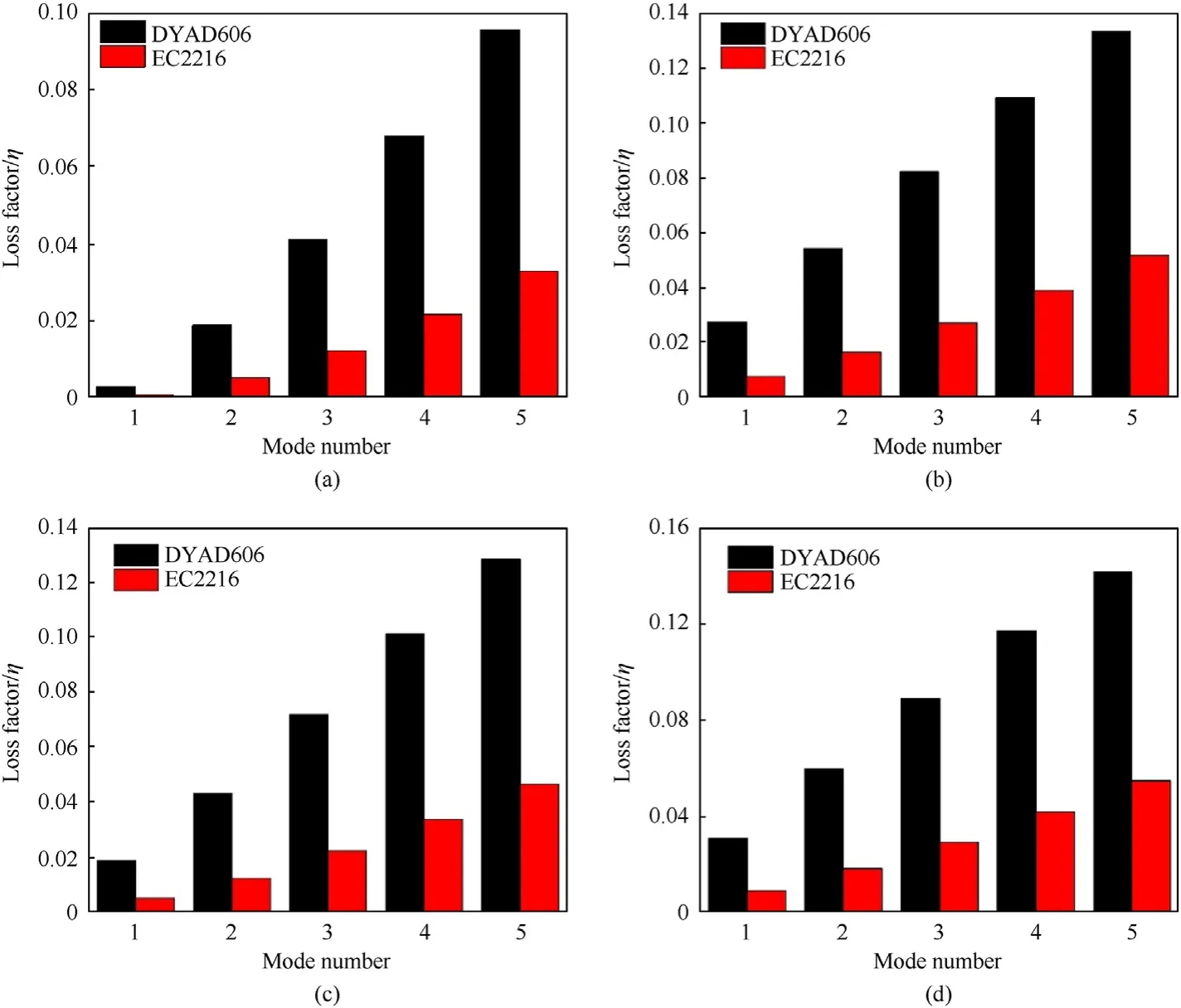
Fig.4.Effect of viscoelastic material on loss factor for (a) CF,(b) CC,(c) SS and (d) CS boundary conditions.
Figs.1(a) and 1(b) illustrate the sandwich beam element with three DOF on each side and the deformation diagram when the sandwich beam element undergoes deformation,respectively.The transverse displacementwis assumed to be uniform at all the locations along the cross-sectional area[41].Furthermore,the energy dissipation in the top and bottom facings is neglected.The midplane axial displacement of theith layer is assumed asui.E1andE3are elastic moduli of the top and bottom face layers.Based on the assumptions,face layers experience compression and tension in an axial direction.The classical theory of the beam/Euler Bernoulli beam theory [22,42] for the present FE formulations.The present study considered a small displacements and strains in the sandwich beam layers.The normal strain of the face layers is given [41].
And shear strain γxzin the middle layer is written as [43]
From Eqs.(2) and (3),the shear strain becomes
Since the sandwich beam is not subjected to any load in the longitudinal direction,the resultant of the normal force in the longitudinal direction will vanish [41],i.e.,
2.1.Elemental stiffness and mass matrices
Lagrange's energy method is used to derive the EOM for the sandwich beam element.The strain and kinetic energy equations are required to obtain the EOM for the sandwich beam with the current method.
The strain energy in the top and bottom facings (V1,3) can be written as [43]
h1andh3in Eq.(10) represent the thickness of the top and bottom facings,bandlrepresent the width and length of the top and bottom face layers.A1=bh1andA3=bh3are thec/sareas andare the second moment of inertia at the centroid of the top and bottom facings.
The strain energy in the viscoelastic layer(V2)can be written as
Gin Eq.(11) is the shear modulus(G)=G′+iG′′andG′represents the real part (storage modulus) andG′′is the imaginary part (loss modulus).h2is the thickness andA2=bh2is the c/s area of the viscoelastic layer.
Total elemental strain energy (Ve) in the sandwich beam element is the summation of energies associated with all the layers.So,
The kinetic energy associated with the viscoelastic fluid sandwich beam is divided into three parts [41] (i) transverse displacements associated with both the top and bottom facings and viscoelastic layer (T1),(ii) axial displacements associated with the top and bottom face layers (T2),and (iii) rotary displacements associated with the viscoelastic layer(T3).And the termsT1,T2,andT3can be written as [41]
ρ1,ρ2,andρ3in Eq.(15)are densities associated with the bottom,viscoelastic,and top face layers,respectively.
The total elemental kinetic energy associated with all the layers can be written as
2.2.Finite element implementation
This present FE formulation considers a sandwich beam element with two nodes.Each node consists of three DOF.The three DOF of each node is (i) axial displacementu,(ii) Transverse displacementw,and (iii) rotational displacement θ.The displacements associated with axial and transverse can be written as a combination of nodal displacement vector and shape functions [44].
In which,{q(t)}={ui wiθi uj wjθj},Nu(x)andNw(x)are beam shape functions.
The elemental stiffness matrix is obtained by substituting Eqs.(19) and (20) into Eq.(18),and elemental strain energy can be written as
The elemental mass matrix is obtained by substituting Eqs.(19)and (20) into Eq.(14),and the elemental kinetic energy of the sandwich beam can be written as
Lagrange's approach is utilized for the present FE formulation to get the EOM for the viscoelastic sandwich beam [45].
The terms in Eq.(27) are [me] -Elemental mass matrix,[ke] -Elemental stiffness matrix,and {fe} -elemental force vector.
The sandwich beam's global mass,stiffness,and force vector matrices can be obtained by assembling the elemental matrices of all the elements considered for the viscoelastic sandwich beam.The final form of EOM for the viscoelastic sandwich beam can be written as [22].
3.Convergence study and validation
The convergence of the solution and validation study for the present FE formulation is discussed in this section.A convergence study is done for two fundamental modes,as shown in Figs.2(a)and 2(b).For this,material and geometrical properties are taken from Ref.[28].
For the convergence confirmation,up to thirty elements are taken.For the cantilever condition,convergence appeared at around 20 elements for the first and second modes,respectively.
The present formulation is validated with the existing literature(see Table 1).The properties [28] utilized for the validation are presented in Table 2.The natural frequency and loss factor values for the cantilever boundary condition are validated and presented in Tables 3 and 4,respectively.The results obtained closely agree with the published Ref.[28].

Table 1 Boundary conditions used for the present study.

Table 2 Properties of the sandwich beam with Length=177.8 mm,and width=12.7 mm and loss factor(η)=0.1,0.2,0.3 [28].
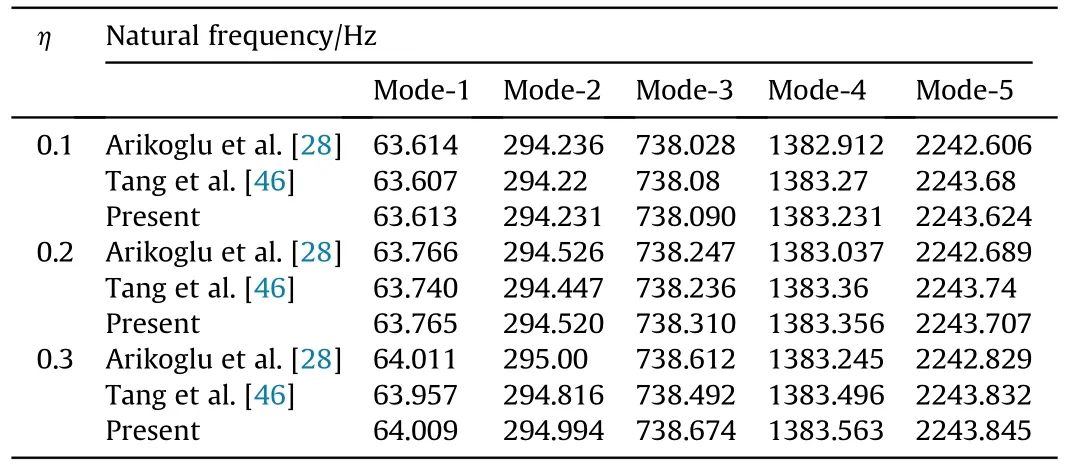
Table 3 The natural frequency of six fundamental modes for different η values.

Table 4 The loss factor of six fundamental modes for different η values.
4.Results and discussion
This section presents an analysis of the dynamic response of sandwich beams based on viscoelastic material(VEM),with a focus on two types of VEMs: DYAD 606 (VEM-1) and EC2216 (VEM-2).The study explores the effects of various factors,such as the type of VEM,boundary conditions,and VEM configuration,on the natural frequency,loss factor,and frequency response.DYAD 606 and EC2216 are used as the core materials for the present study.DYAD 606 composed of a blend of high-quality neoprene rubber and cork particles,which gives it unique properties such as excellent shock absorption,vibration dampening,and noise reduction.ECR2216 is a two-part,epoxy-based adhesive that has viscoelastic properties,making it useful for vibration damping and shock absorption applications [47].
Table 5 shows the material properties utilized for the current study.The length of 300 mm and width of 25 mm is considered for all the results presented.Further,a thickness of 1 mm is taken for both the face layers and viscoelastic material.

Table 5 Material properties of face layers and viscoelastic materials.
4.1.Influence of viscoelastic material
The influence of viscoelastic material on the dynamic behavior of the sandwich beam for various boundary conditions is discussed in this section.The boundary conditions considered are CF,CC,SS,and CS as shown in Table 1.Free vibration study is conducted to get the sandwich beam's natural frequency and loss factor.Figs.3(a)-3(d) illustrates the variation in natural frequency for VEM-1 and VEM-2 viscoelastic sandwich beam for various boundary conditions,respectively.The natural frequency obtained for the sandwich beam with VEM-2 material is more compared to the VEM-1 for all the boundary constraints [48].This is because the storage modulus of the VEM-2 material is relatively more than VEM-1.This leads to higher stiffness of the overall sandwich beam.
The influence of viscoelastic material on loss factor for the various boundary conditions is illustrated in Figs.4(a)-4(d),respectively.For all boundary conditions,the sandwich beam with VEM-1 material has a higher loss factor compared to that of VEM-2 material.This is due to VEM-1 material's ability to dissipate more shear strain energy during deformation,resulting in higher loss factor values[47,48].Additionally,the higher modes exhibit higher loss factor values for all the boundary conditions.
A forced vibration study is conducted to obtain the frequency response of the sandwich beam.A harmonic load with a constant force of 2 N is applied for this.The load is applied in the transverse direction for all the boundary conditions.The frequency response of the sandwich beam for different boundary conditions is illustrated in Figs.5(a)-5(d),respectively.The relative reduction in the peak amplitude of the sandwich beam with VEM-1 material is higher than the VEM-2[48].The reduction in peak vibration amplitude is clearly illustrated in Fig.5 for all the boundary conditions.This reduction is due to more dissipation of mechanical vibration amplitude energy into heat of the sandwich beam with VEM-1 material.This behavior is more helpful for structural applications where higher amplitudes of vibration are needed to controlled.
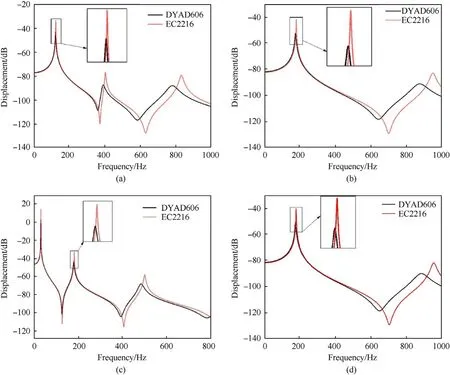
Fig.5.Effect of viscoelastic material on frequency response for (a) CF,(b) CC,(c) SS and (d) CS boundary conditions.
4.2.Influence of boundary condition
The impact of boundary conditions on the sandwich beam's dynamic response is presented in this section.The boundary conditions considered are CF,CC,SS,and CS.The natural frequency of the sandwich beam with VEM-1 and VEM-2 material for the five fundamental modes is illustrated in Fig.6.The natural frequency is less for CF condition at all the modes as the CF condition is more flexible and less stiff relatively compared to the other boundary conditions.The CC boundary condition stiffness is higher due to degrees of freedom fixed on both sides of the sandwich beam compared to CF,CS and SS boundary conditions [43].This leads to higher natural frequency values for the CC boundary condition at all modes.

Fig.6.Effect of boundary condition on natural frequency for (a) mode-1,(b) mode-2,(c) mode-3,(d) mode-4,(e) mode-5.
The variation in loss factor for the sandwich beam with different viscoelastic materials for CF,CC,SS,and CS boundary conditions is illustrated in Fig.7 for the fundamental five modes,respectively.
From the results obtained,it is observed that the loss factor for the CS condition is relatively more compared to other boundary conditions.The CS condition effectively dissipates more mechanical strain energy into the form of heat due to shear action of the core material while deforming than the other boundary conditions.This leads to higher loss factor values for the CS boundary condition at all five fundamental modes.
Further,the percentage(%)of change in loss factor of the VEM-1 compared to the VEM-2 is calculated as follows
The percentage of change in the loss factor with respect to the boundary condition is illustrated in Fig.8.The loss factor of the VEM-1 is increased by 72.98%,71.16%,71.77%,and 71.32% when compared to the VEM-2 at the first fundamental mode for the CF,CS,SS,and CC boundary conditions,respectively.The maximum percentage of change in loss factor is observed for the CF boundary condition.

Fig.8.The percentage(%)of change in loss factor of the VEM-1 compared to the VEM-2.
The mode shapes of five fundamental modes are extracted for all the boundary conditions.Mode shapes are drawn using eigenvectors corresponding to the eigenvalues (natural frequencies).The normalized real and imaginary parts are presented since viscoelastic material is modeled using a complex modulus approach.All the five modes with real and imaginary parts of transverse displacement are drawn for CF,CC,SS,and CS boundary conditions are shown in Fig.9,respectively.
4.3.Influence of axial gradation of VEM
In this section,the influence of different axial gradation configurations of DYAD 606(VEM-1)and EC2216(VEM-2)viscoelastic materials on the dynamic behavior of the sandwich beam is discussed.Four different types of axial gradation configurations of viscoelastic materials are considered.Configuration-1 consists of two portions of the viscoelastic material with the beam's first halflength containing VEM-1 and the second half-length consisting of VEM-2,as shown in Fig.10(a).Configuration-2 also consists of two portions of viscoelastic material,in which first half length of the beam contains VEM-2 and the second half length contains VEM-1 as shown in Fig.10(b).Configuration-3 and 4 comprise four portions of alternative layers of VEM-1 and VEM-2,as illustrated in Figs.10(c) and 10(d),respectively.
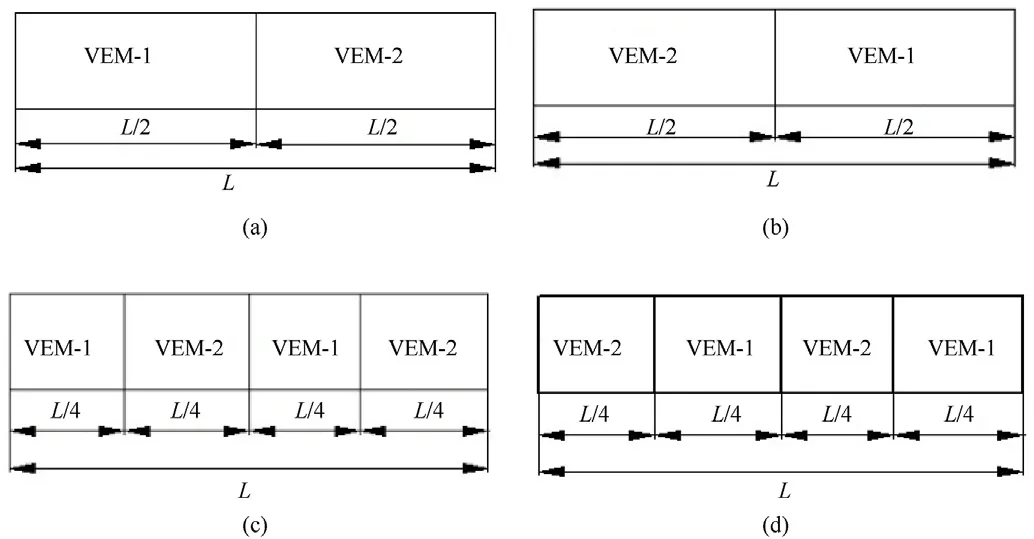
Fig.10.Axial gradation configurations of viscoelastic material:(a)Configuration-I;(b)Configuration-II;(c) Configuration-III;(d) Configuration-IV,respectively.
The influence of different axial gradation configurations of viscoelastic material on natural frequency for the five fundamental modes under CF,CC,SS,and CS boundary conditions are illustrated in Fig.11(a)-11(d),respectively.There is a considerable and minimal variation in natural frequency for all boundary conditions.There is very minimal change in natural frequency is observed for the CC and CS boundary condition.The relative change in mass and stiffness of all the four configurations almost have no impact on the natural frequency of the sandwich.For CC and CS boundary conditions,the natural frequency of Configuration I and II are same and the natural frequency of Configuration III and IV are also same at all the modes as illustrated in Figs.11(b)and 11(d).Configuration-II is able to produce slightly higher stiffness values at all the five modes for CF and SS conditions.The variation in natural frequency is very less at lower modes and there is considerable variation in natural frequency at higher modes as shown in Figs.11(a)and 11(c).

Fig.11.Influence of viscoelastic material configuration on natural frequency for (a) CF,(b) CC,(c) SS and (d) CS conditions,respectively.
Further,the influence of VEM configuration on the loss factor is explored.There is a significant variation observed in the loss factor,as illustrated in Figs.12(a)-12(d) for CF,CC,SS,and CS boundary conditions,respectively.Configuration-I is able to provide the higher loss factor values for the CF,CC and SS boundary conditions at the fundamental mode as shown in Figs.12(a)-12(c).The minimal change is observed in the loss factor for CC condition at all the modes.The influence of viscoelastic material configuration is very less on CC condition,as shown in Fig.12(b).For CF condition,configuration-I is more effective at the first three fundamental modes and fifth mode and configuration-III is effective at 4th mode.For CC condition,configuration-I and II behaved in a similar manner at all the modes and they produced more loss factor values compared to the configuration-III and IV.This may be due to less variation in the ratio of total energy dissipated to total energy stored in the sandwich beam for the CC condition.For SS condition,Configuration-I is more effective at the first fundamental mode where as configuration-III is good at higher modes as shown in Fig.12(c).For CS condition,configuration-II is produced the higher loss factor values at the lower modes where as configuration-IV have provided good damping at higher modes as shown in Fig.12(d).CS condition is produced higher loss factor values compared to other boundary conditions at all the modes as illustrated in Fig.12(d).

Fig.12.Influence of viscoelastic material configuration on loss factor for (a) CF;(b) CC;(c) SS;(d) CS conditions,respectively.
The sandwich beam's frequency response with viscoelastic material configurations for various boundary conditions is illustrated in Figs.13(a)-13(d),respectively.As discussed above,the configuration of viscoelastic material for CC condition has minimal effect on the peak amplitude of vibration,as shown in Fig.13(b).The results show a significant reduction in peak amplitude of vibration for the CF,SS,and CS conditions.The type of viscoelastic material configuration techniques helpful in avoiding the higher amplitudes vibrations for structural applications at particular modes for a particular boundary condition.
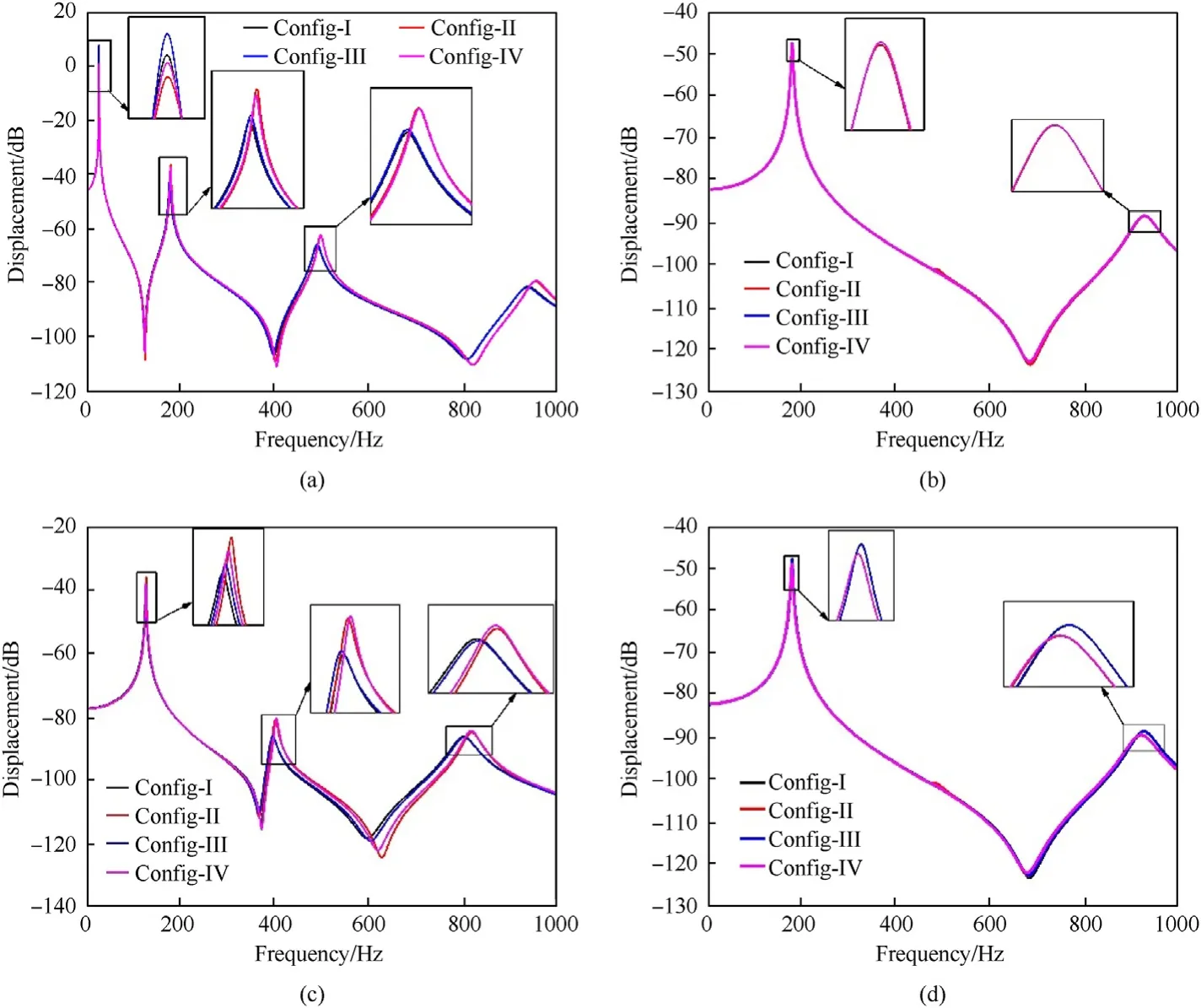
Fig.13.Influence of viscoelastic material configuration on frequency response for (a) CF,(b) CC,(c) SS and (d) CS conditions respectively.
5.Conclusions
The finite element model is derived for the sandwich beam application in the present work.FE code is developed and implemented to get the vibrational behavior of the sandwich beam with viscoelastic material.Further,the influence of type of viscoelastic material,boundary condition and axial gradation of viscoelastic material on natural frequency,loss factor and frequency response are presented.
· VEM-1 material is able to produce higher loss factor values compared to the VEM-2 material for all the boundary conditions considered,and the loss factor value at the first fundamental mode is more for the CS boundary condition.
· The loss factor value of VEM-1 is increased by 72.98%,71.16%,71.77%,and 71.32% when compared to the VEM-2 at the first fundamental mode for the CF,CS,SS,and CC boundary conditions,respectively.
· For CF condition,configuration-I is more effective at the first three fundamental modes compared to the other configurations.
· For SS condition,Configuration-I produced high loss factor values at the first fundamental mode where as for higher modes,configuration-III is more effective.
· For CS condition,configuration-II provided the higher loss factor values at the lower modes where as configuration-IV has given good damping values at higher modes.
· Among all the viscoelastic material axial gradation configurations considered,CC boundary condition has the least effect on the variation in natural frequency and loss factor.This may be due to very less variation in the relative change in stiffness and mass value of the sandwich beam.
· The axial gradation configuration of viscoelastic material has a considerable impact on loss factor and frequency response for all the boundary conditions and this technique can be implemented to the structural applications to control higher vibration amplitudes at particular modes for a given boundary condition.
Declaration of competing interest
The authors declare that they have no known competing financial interests or personal relationships that could have appeared to influence the work reported in this paper.
Acknowledgments
Authors acknowledge the support from the Department of Science and Technology (DST) file no.ECR/2016/001448 titled“Experimental Investigation of Passive,Semi-active and Active vibration control of Composite Sandwich Structure”funded by Science and Engineering Research Board,Government of India.
Appendix
The mass and stiffness matrix coefficients of the present FE formulation are as follows:
Elemental stiffness matrix coefficients
杂志排行
Defence Technology的其它文章
- Interaction of water droplets with pyrolyzing coal particles and tablets
- Multifunctional characteristics of 3D printed polymer nanocomposites under monotonic and cyclic compression
- The concept of sUAS/DL-based system for detecting and classifying abandoned small firearms
- Development of bimetallic spinel catalysts for low-temperature decomposition of ammonium dinitramide monopropellants
- Thrust characteristics of nano-carbon/Al/oxygenated salt nanothermites for micro-energetic applications
- Ballistic response of skin simulant against fragment simulating projectiles
